Lockwood
Custom Optics at the 2014 Winter
Star Party
|
To say it was a brutal winter does not adequately describe it. To use the words I would like to use to describe it would mean that this web page would probably end up on some sort of watch list, banned list, or censored list. Stick your head in a bucket of ice and use your imagination. Where I live, the cold, snow, wind, and just general misery did not end from November to when I left for this trip. There were many days when careful dressing in a heavy parka and covering of most skin was necessary to simply walk out and get the mail. I grew up in Michigan and we rarely had wind chills this bad. Thankfully I was able to escape between snowstorms, though I did have to drive a few stretches of snow-covered roads before I got to southern Illinois and Indiana where the pavement was finally clear. Energized by above-freezing temperatures, steady views of a strange, extremely bright orb in the sky, the name of which I had forgotten, and a chocolate milkshake, I drove on into the night, arriving at the Chiefland Astronomy Village around 11pm after ~900 miles of driving. 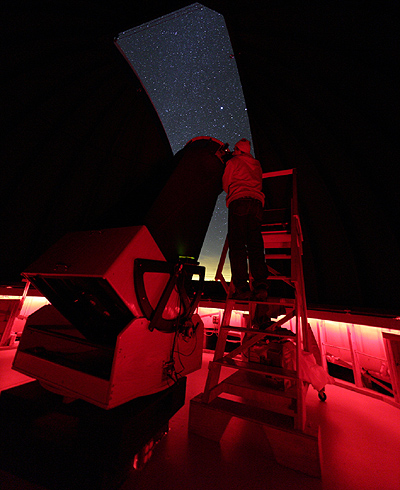 I was met by Doris, but Dana was sleeping with a bad toothache. I had a dark beer and went to sleep. The next day we unloaded a 32" mirror that I had refigured, Dana worked on getting a dentist's appointment, and we did a little work on the telescope. It had been fitted with a larger secondary by one of its owners, and the secondary holder "shell", made of aluminum sheet metal, did not quite fit the mirror properly. It was too small in diameter, so the mirror only contacted at the top and bottomand did not rest against the "lip". It also shifted in the holder as the telescope was moved up and down, so collimation was shifting, too. I spent a few hours of disassembling, reassembling, and evaluating the fit of the holder. I finally decided to use some aluminum from a soda/pop can to increase the size of the disk that the shell attached to. (This is the disk that the secondary collimation screws push against.) We cut some strips of the aluminum, wrapped it around a few times, and taped it in place. The shim made the shell a larger diameter, so the gap where its ends met was now much wider, but this was not an issue. I also had to re-bend some of the lip of the shell, which is what holds the secondary mirror in place. This lip should contact the mirror as uniformly as possible all the way around. The new holder also was flexing, so we butted it up tight against the spider vanes to prevent flexure. Dana was pleased when he came out later, still with tooth pain, and found his scope holding collimation quite well. We observed that night at fairly high powers and I recall an especially good view of M82. With the tooth removed later in the week, we enjoyed some more good observing. At right Dana enjoys the views on his rolling observing ladder, which used to be Tom Clark's. He modified it a bit for his smaller dome. Below the scope is seen, and some clouds to the south reflect a bit of light from a town. Some red lights under the dome framing light the interior nicely, and only appear bright in the image due to the time exposure. 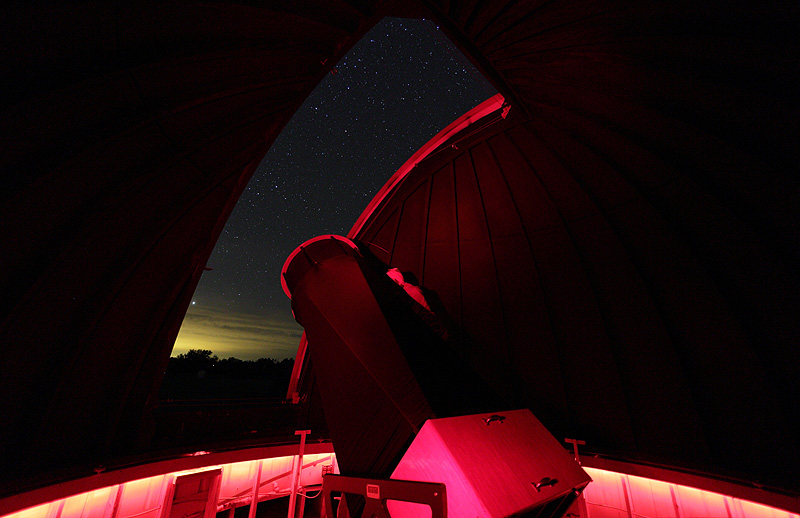 I think the image below sums up Florida observing quite nicely - Dana is wearing a sweatshirt and hat, and that is plenty to keep someone that winters in Florida warm. Also, look where Orion is - It's framed by the top of the dome, high up in the sky. That is what a change in lattitude accomplishes. 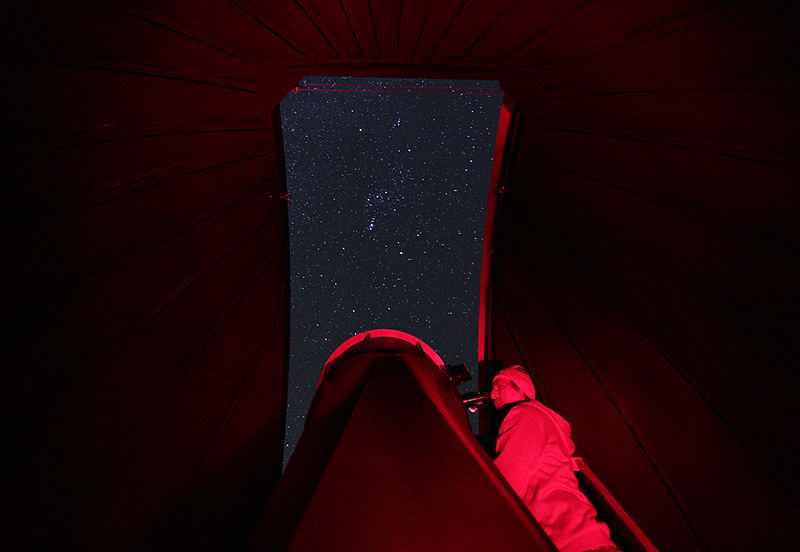 In the image below, the zodiacal light rises up bright and tall behind the dome. The dome doors are open for ventilation, and Bob waves through the dome slit. 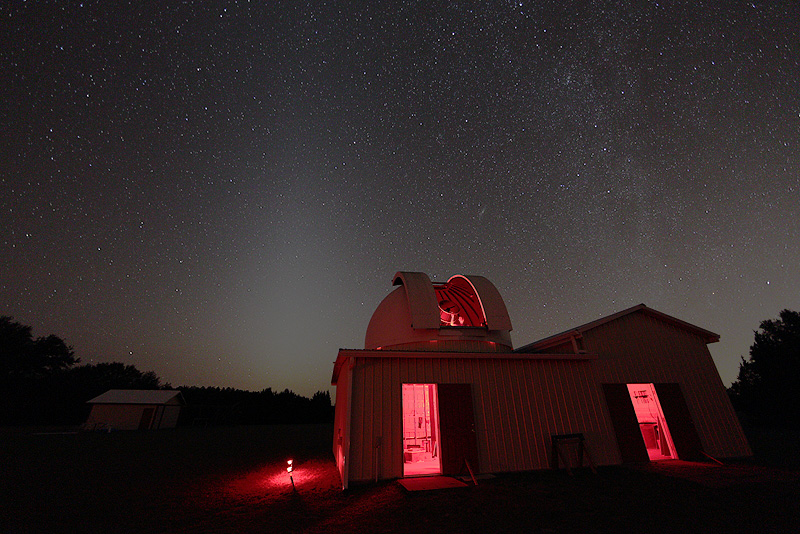 As usual, we had a great time talking to neighbors, and I looked at a few other telescopes while I was there to see how they were performing, at the request of their owners. On my way back through after the Winter Star Party, I was to pick up a primary and secondary for testing and possible refiguring. Of course there are other things to do at Chiefland and nearby, so a little bit of golf was played later in the week, and Bob was working feverishly with the help of John Pratte to reassemble the 32" scope that he had bought recently from John Novak. When I arrived, I had his refigured 32" mirror with me, and they were hoping to have the scope reassembled before John and I headed down to the Keys. They did not quite get it done, but it did not have first light until the weekend after the star party. Below is a photo of Bob with his new scope. 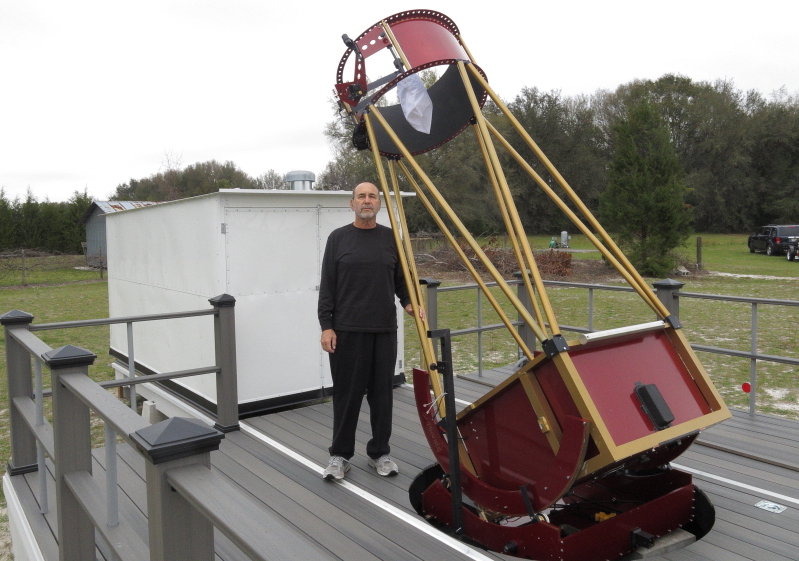 |
This year was the thirtieth anniversary of the Winter Star Party, so there was an extra day, and the event started on Sunday rather than Monday (this happens every ten years). This time a friend (a different Bob than the one above) and I stayed in town to see how we liked that. I had recently refigured an 18" mirror for the Southern Cross Astronomical Society (SCAS), so I was eager to see how it was performing. We claimed a spot to set up in, and I looked for friends and acquaintances to see where they were set up. 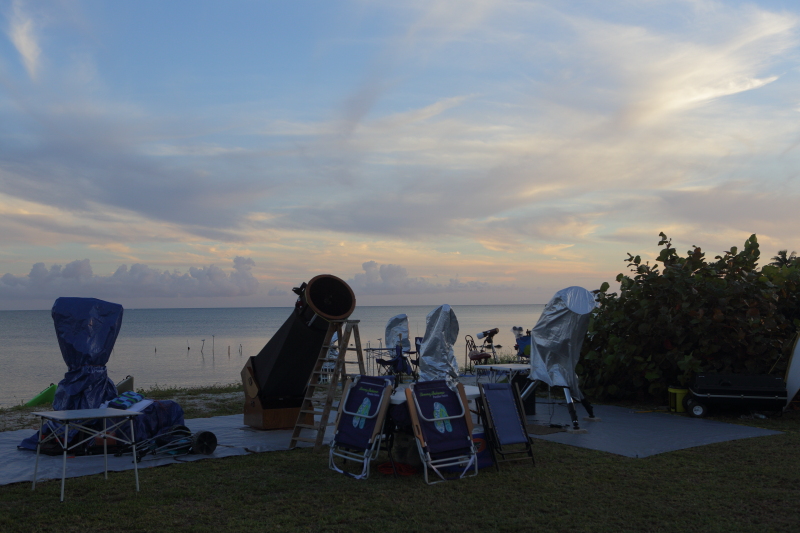 Above you can see the scene on the beach at the Winter Star Party - equipment, some of it covered, waiting to see if the clouds will part. Colorful tropical clouds float in the distance, lit by the setting sun. 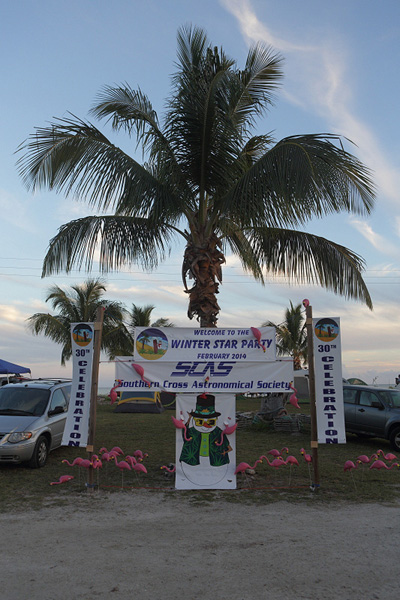 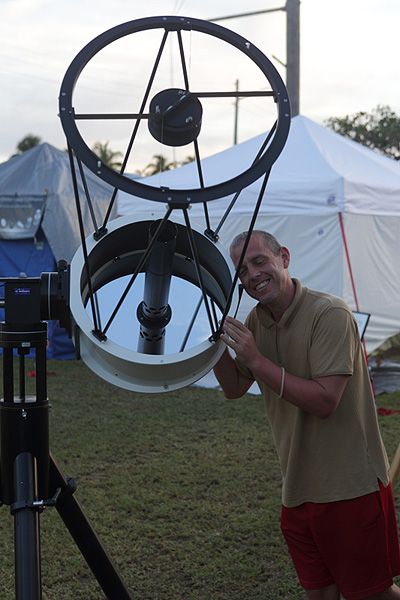 Before the sun went down, I took a photo of the welcome signs at the end of the driveway, and I also tracked down Matthias to see an 18" Cassegrain. He is very fond of his telescope, as you can see above, and I am too, since it has my optics in it. 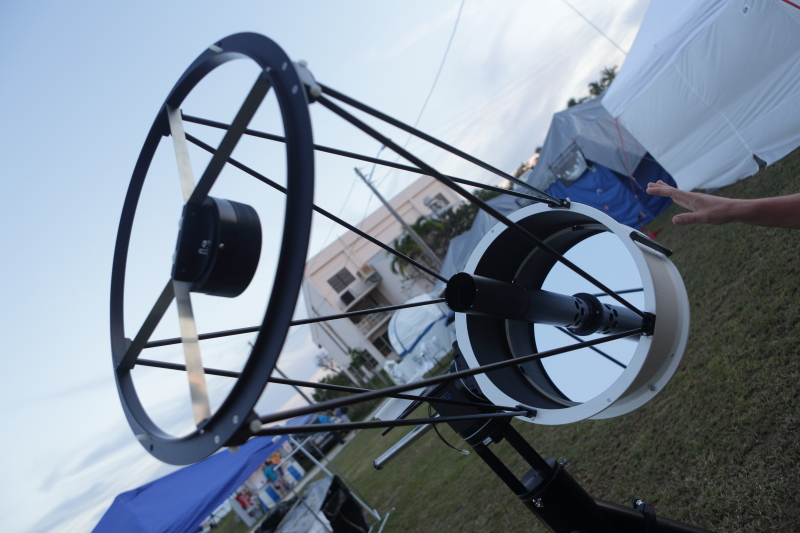 The Cassegrain was here to provide views of the planets and deep sky objects under steady, tropical skies. Finally darkness began to fall, and skies were clearing. Everyone was scrambling to get their scopes ready to go - you never know when superb conditions might materialize here, so we like to be ready. Below John Pratte of JPAstrocraft (right) checks his 25" f/4 scope as it starts to get dark. Larry (left) and his friend prepare their observing accessories for his friend's Questar. In the background, Joe prepares for observing withi his 32" f/3.6, which is seen behind the 25" f/4. This scope is usually set up back against the trees to shelter it from the typical ocean breezes, which reduces shaking and improves high-power images, which that scope delivers whenever conditions allow. Both the 25" and the 32" feature my optics. 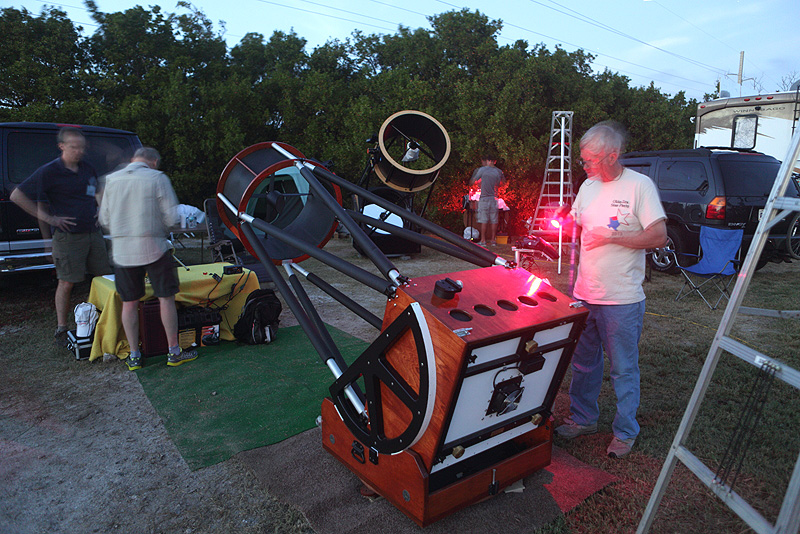 |
As it turned out, it was truly a memorable evening. Winds were nearly calm. Joe used a box fan to help cool his 32" mirror. Temperatures were delightful - I was observing in February wearing shorts and a t-shirt at night with no bugs to annoy me. Life is good. As darkness fell, scopes were pushed, aimed, and slewed to bright Jupiter. Joe's 32" and John's 25" pointed high at the sky at the untwinkling Jovian beacon, and phrases began to be uttered that are not heard that often, even here in the steady Florida Keys. "Oh my God." "That is incredible!" "It looks like a Voyager fly-by!" "Where is Damian Peach, he should be recording this!" My reaction when I looked through John's 25" f/4, was simply "This is the best view I have ever seen of Jupiter through a telescope". Jupiter was mind-warpingly good at 600-700x in the 25" and 32". Polar regions and regions between belts resolved into tiny wisps. Belts showed tiny crazy-colored streaks. There was too much detail to describe. The red spot rotating onto Jupiter's disk with high-contrast clouds swirling all around it was a sight I will never forget. Darren, who was doing the kids programs this week, was running around almost in a fervor with a friend who also couldn't believe the views. I think I told him to take a deep breath! At one point I observed the moons one by one - I could see features when they stopped moving due to the seeing. It was like observing Mars in a smaller scope, except there were four Mars of different sizes and colors! As it cooled off, the performance of the 32" f/3.6 caught up to the 25" f/4. With even more light grasp and resolving power, I found that I could see slightly more detail than with the 25", but the 25", being a smaller, thinner mirror, had the early lead. My friend Bob arrived after dark, and on his way into the camp he overheard people talking about the amazing performance of some "very large telescopes" at one end of the observing field, so he knew where we were set up without even having to ask! I also checked out a few objects through the 18" Cassegrain, and it was performing very well, producing high-contrast views of Jupiter and M42, to name only a couple of objects. Clouds finally came in around midnight, and we left around 1am to go get some sleep, with visions of an ultra-detailed Jupiter still bouncing around in our heads. I had to have a beer to calm down. We slept in as long as we could and took it easy on Monday. Tuesday night featured more Cassegrain observing - M42 was superb, as were the Eskimo, M51, and M82. The companion of Sirius, the Pup, was easily visible. Overall the seeing not quite as good, and there was occasional haze. Jupiter was still nice, with the planet being breathtaking at ~1300x at moments in the large Newtonians. Albedo features were visible on several of the moons, and at 1300x they were again somewhat like observing Mars in a small scope! Joe was still using a fan behind his 32" f/3.6 to stir the air like a natural breeze would. This resulted in faster cooling, and much less noticeable cooling-induced overcorrection. The correction looked quite good, and produced much better images than another noticeably-undercorrected large telescope that was down the beach a bit. The Raspberry (IC281), Ghost of Jupiter, and Eskimo were all excellent at high power. We used ~1300x on Eskimo, not quite as much as other years. M46 showed nice detail in the NGC planetary. Thor's Helmet under these skies simply looks like a frog to me. It was a beautiful view, with huge extensions of the nebula evident. Mars was low, but showed polar caps and many other features. A bright white feature was seen on limb, possibly clouds. Clouds again came just before midnight, and we left at 1am. The image below shows our observing area on Wednesday night. Notice anything different? 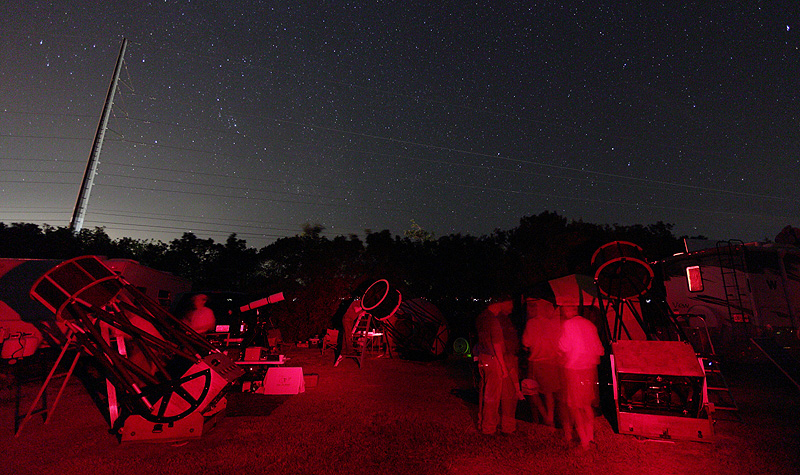 There is another scope - a second 32" f/3.6, this one built by John Pratte (JPAstrocraft) - at right. Its owner is Kirk Collins from Maryland. Between the three scopes and owners there were a variety of objects to view, but also comparisons to make. The two 32"s performed quite similarly optically, but cooled a bit slower than the 25". This is to be expected. With telescopes of similar optical and mechanical quality, as these are, all located close to each other, the other differences become plainly visible, such as differences in thermal performance/cooling. 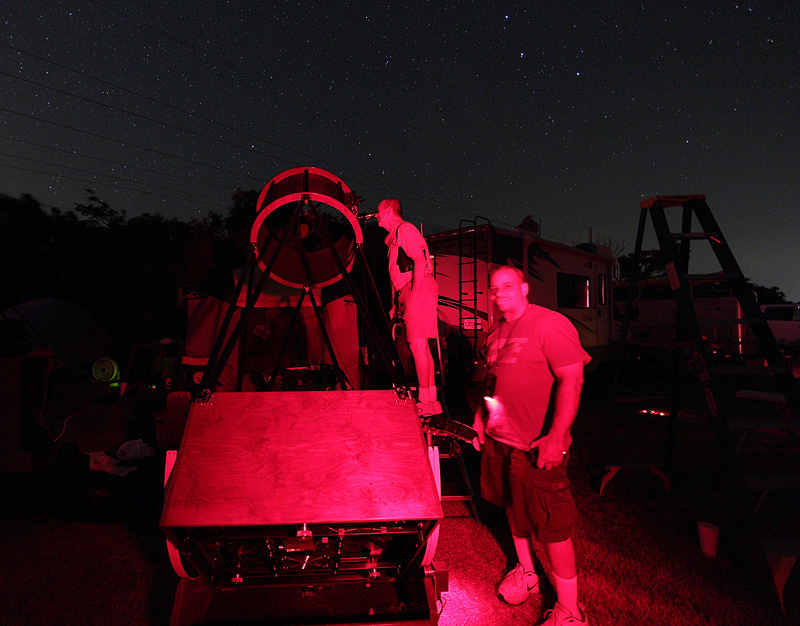 The image above shows Kirk (at right) with the new 32" f/3.6 JPAstrocraft scope. They (and all of us) were very pleased with its performance and the ability of the offset spider to resist twisting and vibrating in the wind. Optical performance was essentially identical to Joe's 32" f/3.6. 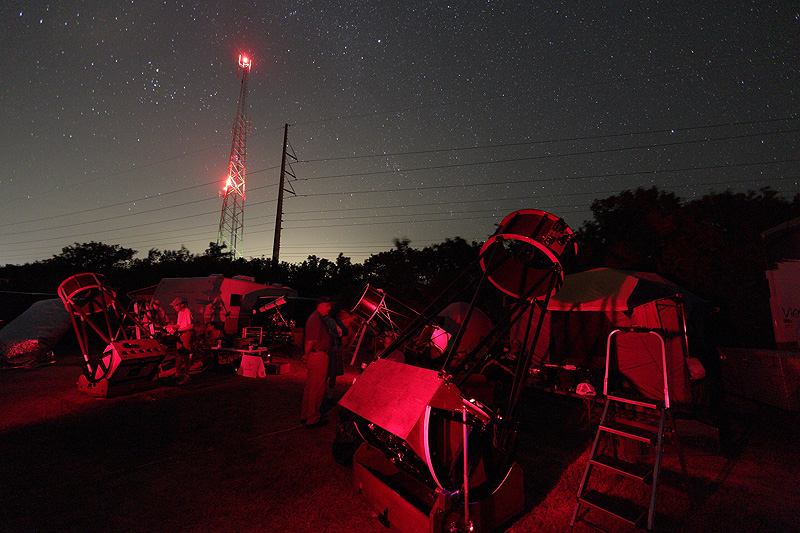 Here's another view of the observing area, with the 32" f/3.6 JPAstrocraft scope closest to the camera, the other 32" behind it, and the 25" f/4 at left. Behind all are the microwave tower that is across the road from the camp, and some light pollution from Big Pine Key. 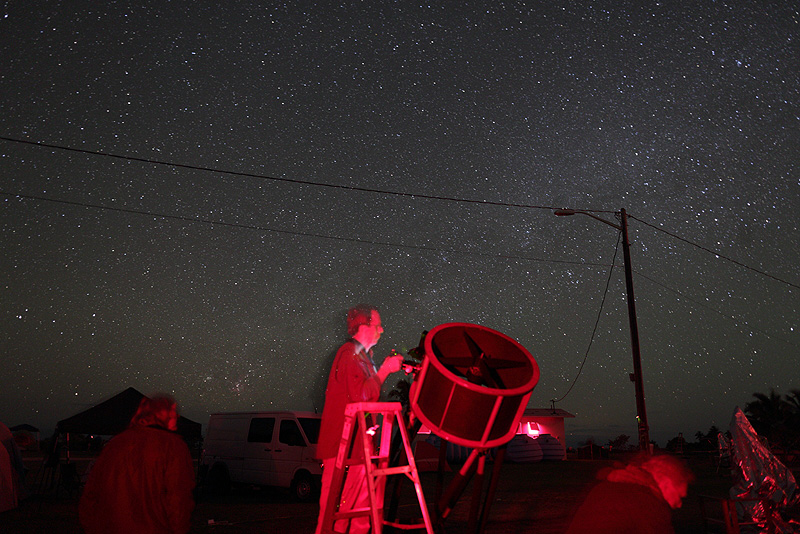 Above Larry changes eyepieces in the 25" f/4. The Milky Way crosses the sky behind him, and the Eta Carina nebula is just above the white van in the background. Other people wander around, waiting for a look. A daytime image Kirk, Sheldon, and the 32" f/3.6 is below, taken by John Pratte. Kirk is extremely happy with his telescope, and as of the writing of this article, it has been to more than one other star party. I even heard that someone didn't look through the telescope on purpose because he was afraid he might be hooked by the views! 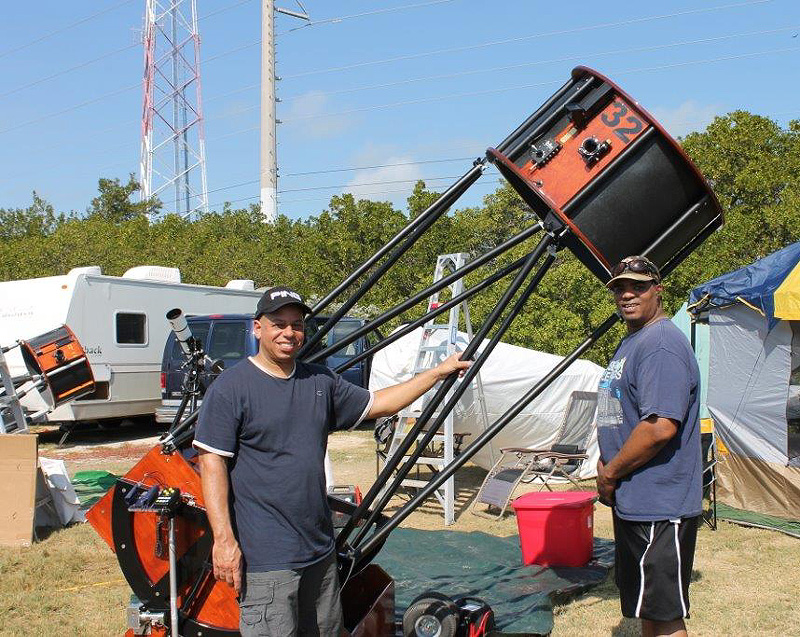 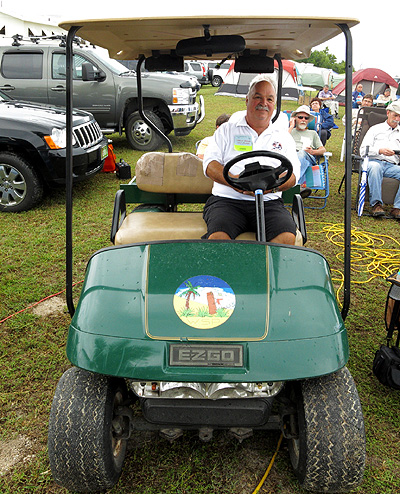 On
Wednesday night the Cassegrain was finally on a tracking
mount, and it was providing stunning images of Jupiter and M42 with
binoviewers. On
Wednesday night the Cassegrain was finally on a tracking
mount, and it was providing stunning images of Jupiter and M42 with
binoviewers.M82 was nice in all of the larger scopes. Jupiter looked the same in both 32" scopes - quite detailed in good moments. Lines formed at all three scopes as the word of their performance had gotten out. The wind picked up, but Mars still looked quite good in moments. I began to work on debugging a 24" scope - I suspected another pinched secondary mirror, and we decided to investigate further the next day. After a lot of observing we left about 1:30am. At right is Charlie - he and others from the SCAS work very hard to make sure the star party goes off smoothly. So, the next time you see him, thank him, and also ask if he wants to play through! On Thursday I gave a talk at 1pm. The talk was based on my article "Why Aren't My Stars Round?" The room was very crowded, and it was a good crowd with excellent questions. There was an unexpected European "commercial" just before my talk, which made it start late. Not considerate. However, the talk went well, and I think the audience left with a better understanding of the things that can go wrong with telescopes and how to identify and fix the problems. At least one person who was there thanked me several months later for helping them to disgnose some mirror cell issues, and then he ordered a large mirror! In the afternoon there was some good BBQ and six huge cakes to commemorate the 30th anniversary of the Winter Star Party. As darkness fell, clouds, wind and some rain move in. Sitting in a beautiful motor home, we disassembled the secondary holder for the 24" telescope and added a foam plug to it, which we carefully crafted while trying not to make a mess in their nice motor home. I worked on the shell part of the holder some to make it fit properly. The larger secondary holders often don't fit properly, and have to be modified. I reassembled it with the foam plug and the proper amount of "stuffing", and finally it was sitting in the holder correctly, slightly loose and contacting the lip of the holder all the way around. We headed back to town around 9pm to enjoy some good craft beer and relax. |
On Friday morning there was the door prize drawing. A few friends won things. Layers of clouds kept the sun off while we sat and listened to the numbers being read off. Usually it is quite hot during the drawing, but this one was very comfortable. 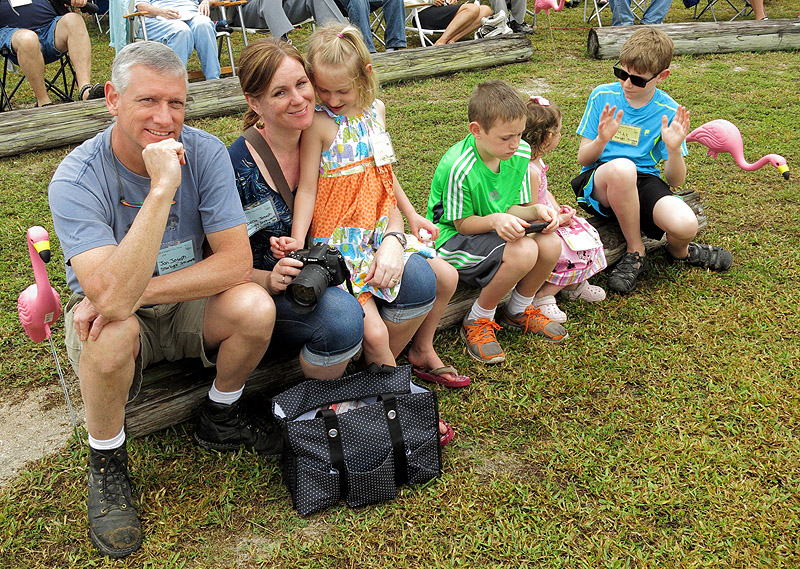 Above the Joseph family waits to see if they have won anything. Jon, at left, makes the Feather-Touch focusers that are so wonderful to use, and the Starlight Integrated Paracorr System (SIPS) that I highly recommend and use on my own telescoeps. This is their family's mid-winter break from nasty Indiana winters. At 1pm some of us left for Key West, and spent part of the afternoon sampling some beverages at the World of Beer. 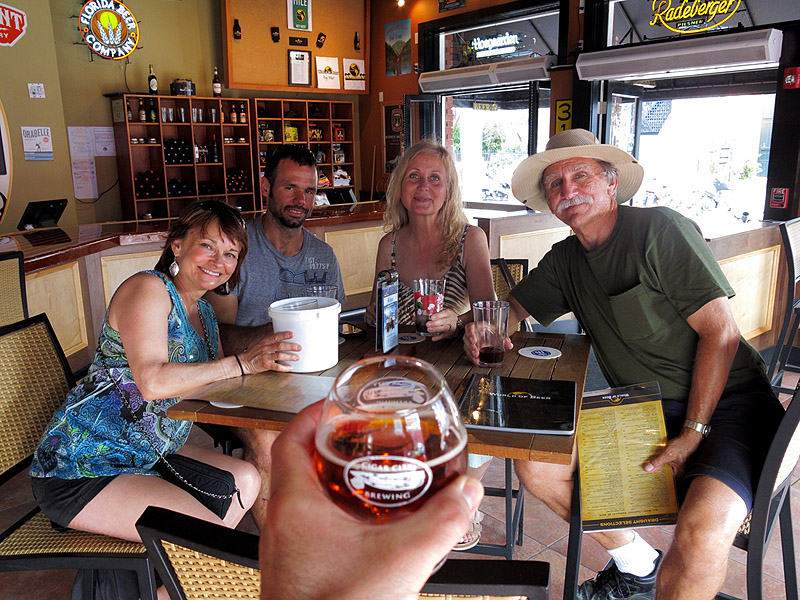 That's my hand holding the beer, a delicious bourbon-barrel ale of some sort, and, from left to right, Lisa, Joe, Doris, and Dana. They are clients and friends who share the views through their telescopes with many people. We had a great time relaxing in the relatively empty World of Beer in what is often the very crowded and touristy Key West. Then we headed back to the star party very relaxed. Friday night my ride back to town was leaving, so I had to stay on site until another person who was staying at the same place was heading back, which would be at first light. So, this was almost an all-nighter, something that I don't normally do. Observing early was cloudy, but then it cleared. Then more clouds formed, but it cleared again for the rest of the night. This is typical Keys weather - if it is cloudy, just sit down, relax, listen to the waves and palm trees in the breeze, and usually it will clear off. Take a nap if you can! Checking back in on our work, the 24" scope was fixed - stars were now round - and was performing well. Overall, the seeing was not great, but we still had nice glimpses of Jupiter. Transparency was good. 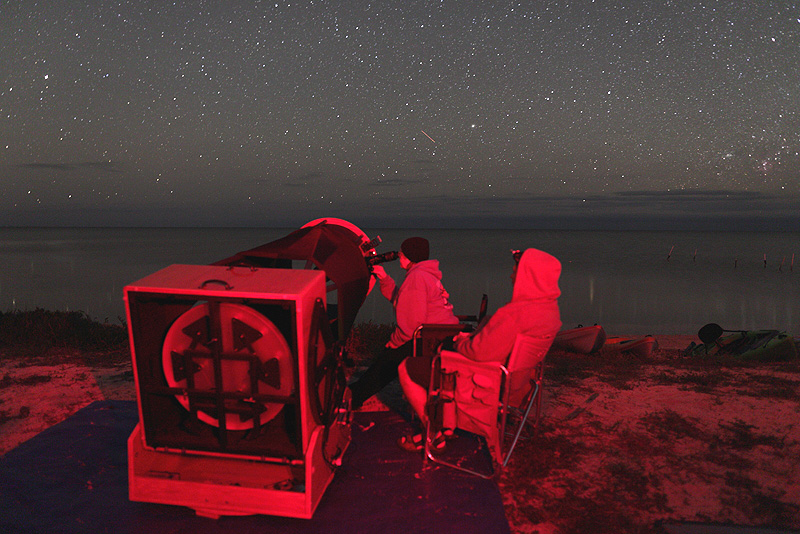 Above Gary and Vandy enjoy their Starmaster on the berm. Note the reflections of stars on the water. This meant the wind was nearly calm. Omega Centauri is the larger blob just above the seated observers, and Eta Carinae getting lower at far right, just above a few clouds low on the horizon. With the wind calming down, I went to the beach with my camera and tripod to try to shoot star reflections. I had to avoid others' shots of objects low in the southern skies, such as the Coal Sack, etc. Returning to the valley of the large high-quality dobs, I observed some more, and the gloriously bright Omega Centauri looked superb in Kirk's 32" f/3.6. Joe's 32" was covered. I returned to the beach with Dana's iOptron camera tracker (which is on my list of gear to buy) and a 14mm lens. I shot star reflections and the rising summer Milky Way and setting southern cross. These images proved to be my favorites of the event. 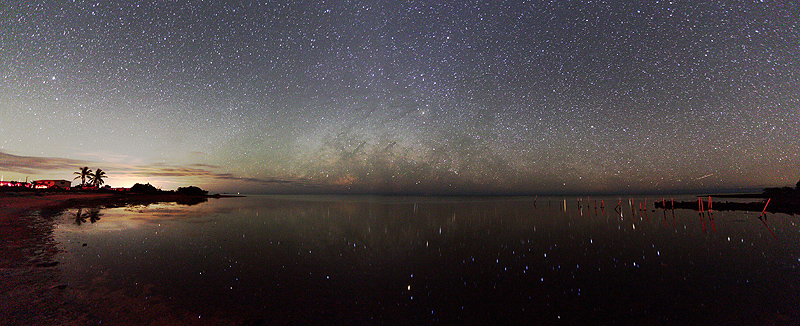 The image above is the result of merging two images from my 14mm wide-angle lens, each with approximately a 50 second exposure. Horizontally the field of view is about 180 degrees. It exceeded my expectations, combining the rising summer Milky Way with reflections of the brighter stars in the sky and also the lights of the camp, old dock pilings at right, and palm trees silohuetted against the light pollution visible from Marathon, Florida, which had some clouds over it at the time. A large print of this will be hanging on my wall at some point in the future. Returning to the valley again, Kirk was still observing, and M51 looked superb. I went back to the beach one last time to shoot Venus rising with the summer Milky Way, with a nice reflection on the water, as seen below. The bright two stars at right are Alpha and Beta Centauri. A few fairly dark clouds hover in front of the Milky Way. 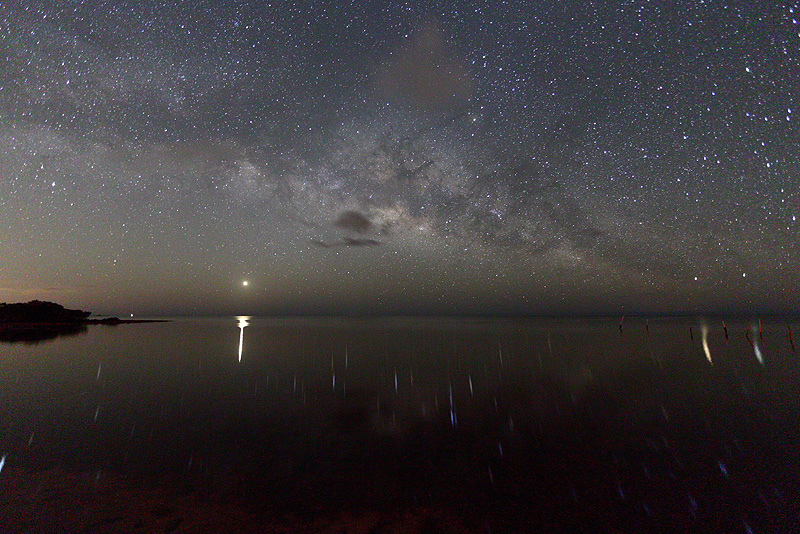 Now it was about ~4:30am, and I was finally getting tired. Both 32"s were covered. It was time to turn in for a couple hours of sleep. Jeff woke me up (as well as the entire bunkhouse!) around 6:30am, and we headed back into town for a little more sleep. Then we packed up and returned to the camp. Saturday night was brief - we were all tired, and turned in as clouds came and went, so most of us turned in early. The next morning we packed up and headed back to reality. I spent some more time in Chiefland, picked up a 28" mirror for refiguring, and headed home to the hell that was the winter of 2013-2014. Clear, dark skies, warm weather, good friends, good seeing, and cheers. See you at WSP 2015. -Mike Lockwood, Lockwood Custom Optics |